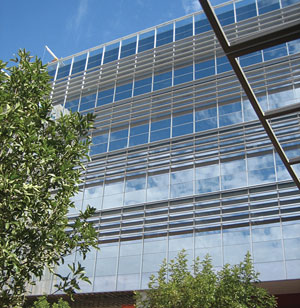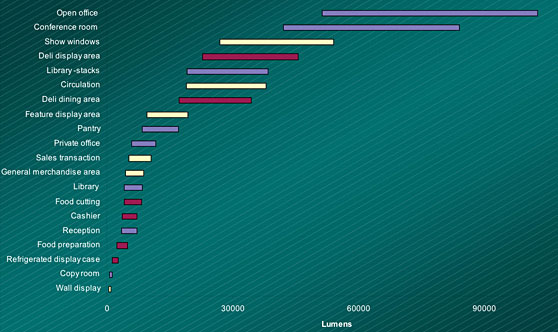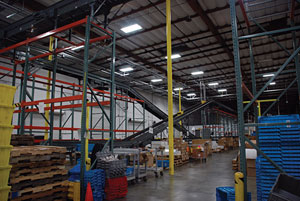The Future Looks Bright: Energy-Efficient Lighting Technologies
 |
The new Chandler, Arizona City Hall, designed by SmithGroup, was intended to provide effective daylighting, avoiding glare and solar heat gain. Photo: SmithGroup |
With technology changing quickly in this arena, many designers simply work with what they know. For that reason, Perkins+Will principal Joan Blumenfeld recommends working with a lighting designer or consultant to stay on top of the latest improvements in lighting design. "Architects and designers tend to overlight space to build in a safety factor, whereas a lighting consultant will calculate exactly how much lighting is required, and no more," she explains. "Facilities managers may be concerned about installing too many fixture and lamp types, which means more to stock and replace. They often want to use what they know, which may not be the most efficient type."
Another mistake is swapping initial outlay during the construction phase for increased operational cost over the life of the building, when doing the opposite often pays for the increased first costs. Other important points for designing efficient lighting applications include:
- Specify carefully for each application. Tailor the lighting technique, system, source and fixture to the various spaces within the project to yield the highest performance and efficiency. For example, indirect lighting like cove lighting can provide warm accents at a low cost, using LED festoon and rope sources that help meet energy code requirements. According to ELP's Maines, novel cove fixtures include continuous, field-cuttable castings integral to the fixture, which reduce installation labor and costs.
- Make use of natural light. Daylighting has become key to efficient and sustainable design, but it's not always an appropriate choice. Depending on site positioning and climate, it can increase occupancy costs for cooling, for example. Corney recommends daylighting though the ceiling where possible, noting "It's significantly more effective, because glare and heat gain can be controlled much more easily."
 |
The David L. Lawrence Convention Center in Pittsburgh uses a daylight harvesting system to cut energy consumption by 35%, an annual savings of about $500,000 per year. Photo: Leviton |
- Allow occupants to control illuminance. Different times of day will call for more or less light, and efficient systems include dimming and other adjustability features controlled by the occupants. "Quite too often we exclude people - the human experience - from the equation," says Milena Simeonova, AIA, IES, LC, A IALD, a lighting consultant based in Riverdale, N.Y. "A new trend in design is the involvement of the end-users, so controls should be present and capable of adapting to the users' demands."
- Rank efficiency among projects goals. Reducing energy use is rarely the top priority. "Nor is our job just to meet the light levels designated in the IESNA Lighting Handbook," says Simeonova. "It's to understand the specific space, to role-play with the people who use the space, and to listen to what they need and like - and then push for creative and simpler solutions."
Suitability is a driving force for sustainable design, Simeonova adds. A properly lit space is a comfortable and healthy one - reducing eye strain, increasing productivity, boosting occupant satisfaction - which increases the building's usefulness and life span. The project team starts by balancing efficiency with a healthy regard for the needs and goals of the people who use the buildings.
| Commercial - General Applications |
 |
This chart shows the range of required lumen levels for specific areas in commercial property types. A team at Rensselaer Polytechnic Institute devised this table as a guideline for architectural applications of LED devices. Source: Lighting Research Center, Rensselaer Polytechnic Institute |
| Controls Cut Lighting Energy by 40 Percent in Warehouse | ||
Warehouses and distribution facilities tend to suffer from poor lighting quality, not to mention lost opportunities in energy savings. This was true for a 350,000-square-foot facility in Northern California operated by not-for-profit health plan giant, Kaiser Permanente.
To improve the situation, facility manager Marvin Cave oversaw a complete retrofit of the lighting system that added new, energy-saving controls. The upgrades, led by Concord, California-based Alamo Lighting vice president Robert Ofsevit, included several hundred occupancy sensors and time switches. Prior to the upgrade, Kaiser Permanente's metal halide, high-pressure sodium and outdated fluorescent sources were powered on continuously from Sunday night through Friday afternoon. New systems would reduce those kilowatt-hours while improving the uniformity of light distribution to ease employee tasks. The new system uses a single lamp type - a 5000 °Kelvin, 4-foot, long-life T8 fluorescent tube. In warehouse rack aisles, passive infrared (PIR) occupancy sensors are linked to individual six-lamp high-bay fixtures. Aisleway lenses sense workers approaching rack areas, powering on corresponding fixtures; otherwise, they remain off. Similar sensors control about half of the fixtures in packing areas and main aisles, where forklift traffic is high. Under mezzanines, Ofsevit designed small task zones: About half the fixtures stay on, and the rest are operated by employees, as needed, via a digital time switch. Dual-relay wall switch sensors control bilevel lighting in private offices, switching automatically to 66 percent upon occupancy with an additional 33 percent available manually. In open office areas, lunchrooms and break rooms, ultrasonic sensors - which can sense around partitions - control illumination levels. A time clock takes care of secure storage rooms. "The lighting upgrade has improved the quality of lighting in both the office area and warehouse, and saved a significant amount of energy and utility costs," says Cave. Proof is in the utility records, which show a 40 percent savings over the first year - enough to pay for the upgrades in only three years. |










